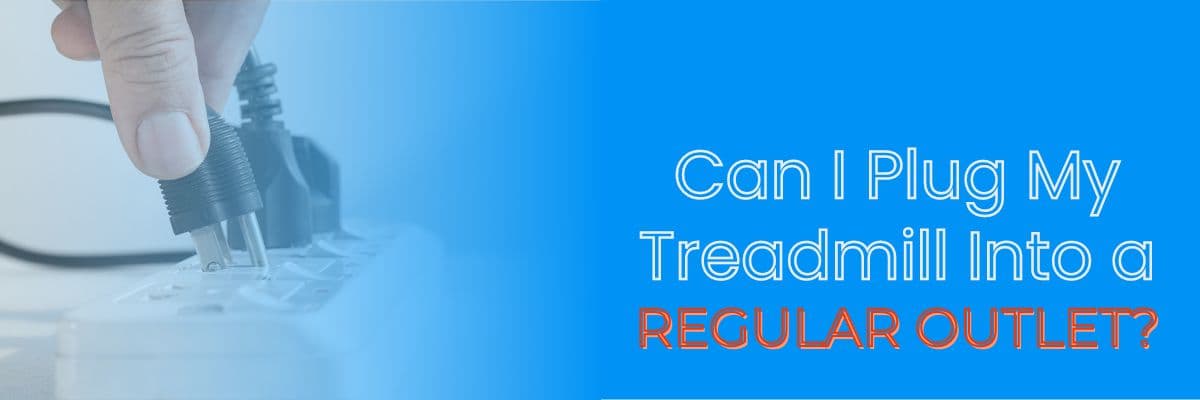
Do you want to get in shape but don’t want to sign up for a gym? You may be wondering if you can plug your treadmill into a regular outlet. Don’t worry – we’ve got the answers you need.
In this blog, you’ll learn whether or not it’s safe to plug your treadmill into an ordinary wall outlet.
It’s important to understand what type of outlet is needed for your treadmill so you don’t end up with an electrical hazard. While there are some portable treadmills that can plug into a regular household outlet, there are other models that require special considerations such as a dedicated outlet, an increased wattage output, or use of a surge protector.
This guide will provide key details you need to consider when connecting your new treadmill to ensure it runs safely and at its optimal performance level.
Electrical Requirements for Treadmills
Most modern home treadmills will require a dedicated outlet with a maximum of 20 amps. Before plugging in your treadmill, it is important to make sure you have the correct type of outlet and the proper electrical supply available. You will need to be familiar with both your home electrical panel and the product manual for your treadmill before connecting them.
Treadmills typically require an NEMA 5-20R 120-volt receptacle to ensure the machine receives enough power to run safely and efficiently. Depending on the model, some machines may need a more powerful outlet such as an NEMA 6-20R which will accept up to 240 volts at 20 amps. If you are not sure which type of outlet you have or if you can install one, it is highly recommended that you contact a qualified electrician prior to connecting your treadmill.
In addition to having adequate power, other considerations include making sure there is room around the machine for any cables or cords that are used during operation and that there is proper ventilation around the motor housing so it does not overheat. Be sure to keep all electrical components away from areas where they could get wet or damp; avoid running cords underneath carpets or near water sources such as sinks and toilets.
Finally, check local ordinances in your area before determining where you can put your treadmill; some places may prohibit its use within certain areas of the home due to fire codes or other safety regulations.
Advantages of Plugging a Treadmill into a Regular Outlet
Plugging a treadmill into a regular outlet can be beneficial in various ways. Firstly, it eliminates the need for complex wiring and dedicated outlets. Secondly, it is more convenient than having to install a dedicated outlet as it allows you to plug your treadmill directly into a wall socket or plug it into any regular extension cord or surge protector with the right power capacity.
Thirdly, this allows you to use your existing outlets without purchasing new electrical supplies or additional outlets. Finally, it prevents the risk of electric shock hazards when using an extension cord that is not designed for this purpose. Additionally, using an extension cord with too much wattage can potentially damage the appliance and create more potential for electric shock hazards in your home.
Disadvantages of Plugging a Treadmill into a Regular Outlet
Before plugging a treadmill into a regular household outlet, there are a few disadvantages to consider. Using an outlet for a powerful appliance can cause electrical damage if the circuit or breaker is not designed to handle the appliance’s power rating. Most treadmills draw an excessive amount of power and can cause long-term but potentially damaging risks when plugged into a regular outlet such as:
-The circuit breakers may trip off or blow due to higher than normal current flow. This can bring power outages or worse.
-If the treadmill is too powerful for the circuit, the wiring in your house can become overloaded and heat up, leading to possible fire hazard or electrical shorts.
-Insufficient voltage supply from the outlet may end up damaging sensitive electronic components of your treadmill, potentially leading to irreparable damage in some cases.
-An undersized breaker may lead to sparking and arcing, causing further fire hazard risks with serious consequences.
-Computerized features on advanced treadmills will be unable to operate effectively at lower voltages when plugged into an ordinary household outlet that is not equipped with surge suppression devices.
Safety Considerations
It is important to consider the safety of plugging a treadmill into a regular power outlet in your home. Treadmills require more power than conventional household appliances—the average treadmill needs a dedicated 20 amp, 120-volt circuit. This can be accomplished by simply hardwiring the machine or plugging it into an outlet that allows for an increased wattage load.
When determining if regular outlets can be used for powering your treadmill, first ensure that it is the correct type of outlet and check the ambient temperature ratings. The outlet should be labeled 125VAC/15A for floors or walls, and should have an ambient temperature rating of 105°F (40°C) or less. Your manufacturer’s materials will indicate whether an ordinary outlet can be used to power your machine.
If you’re not sure if you have a dedicated circuit in your home, it would be best to contact a local electrician who has safely wired treadmills before to inspect and properly install the electrical wiring you’ll need for safe operation of your treadmill. Additionally, make sure that any potential safety hazards are addressed with respect to the location of the treadmill in relation to other objects, cords and devices as they can create potentially dangerous tripping hazards when using the machine.
Troubleshooting Tips
For most modern treadmills, the answer is yes — it’s generally safe to plug a treadmill into a regular outlet. The current (amps) and voltage required by most residential-grade treadmills will not exceed the capacity of the standard 15 or 20 amp circuit usually found in homes. However, for maximum safety, it is always good practice to plug your treadmill directly into a dedicated circuit or outlet. To be sure, consult your owner’s manual for details regarding the specific requirements of your particular device.
If you are not comfortable wiring an electrical device or if you lack expertise in this area, contact a licensed electrician who can identify any issues with your existing wiring before you connect your treadmill to it. Your electrician can also install a dedicated circuit for you if necessary.
Treadmill motors adapt their resistance according to how hard they need to work; this requires more amperage than other household appliances. Therefore, these appliances should always be plugged directly into their own dedicated outlets that are wired properly and grounded in order to ensure proper operation and adequate power supply as well as prevent overload of the circuit and fire hazards.
Alternatives to Plugging a Treadmill into a Regular Outlet
If you are considering plugging your treadmill into a regular outlet, it is important to understand the dangers and know other alternatives. The majority of treadmill motors draw a high amount 1050-1550 watts of electrical current, making it potentially dangerous to use a standard household outlet. Outlets are typically rated for 20 amp or less service and the motor could easily create a wiring overload or fire if connected directly to the same circuit as other household appliances such as televisions, computers etc.
Fortunately, there are several safe alternatives for powering your treadmill. Firstly, you can purchase an extremely helpful Surge Protection Device (SPD) that will help regulate the electricity coming from your standard outlet to protect more delicate items such as computers, audio equipment and yes, even your treadmill. This device can be found at any home improvement store or online retailer.
Secondly, you may be able to install a dedicated outlet in your home that draws from a different breaker than all other outlets in your house – but this should be done by an expert electrician due to safety concerns.
Lastly you can purchase extension cords rated for high wattage like 10 gauge 15A or greater that offer surge protection up to 2400 watts with secure locks on either end – but always check with your manufacturer first before attempting this solution as it is not recommended for some treadmills models specially newer styles.
Conclusion
In conclusion, it is possible to easily plug your treadmill into a regular outlet. All you need is a three-pronged plug, an extension cord and the right voltage adapter. It’s important to follow all manufacturer’s instructions regarding the plugging in of any electrical appliance. This includes ensuring that the outlet and cord are rated for the amperage requirements of the treadmill.
As always, if in doubt, consult an electrician or qualified technician when setting up any electrical appliance.

